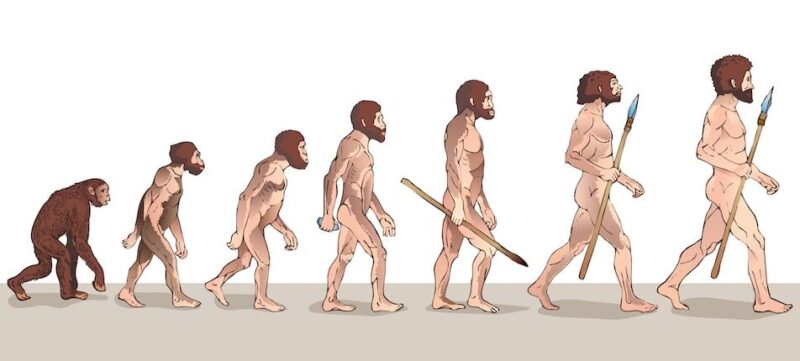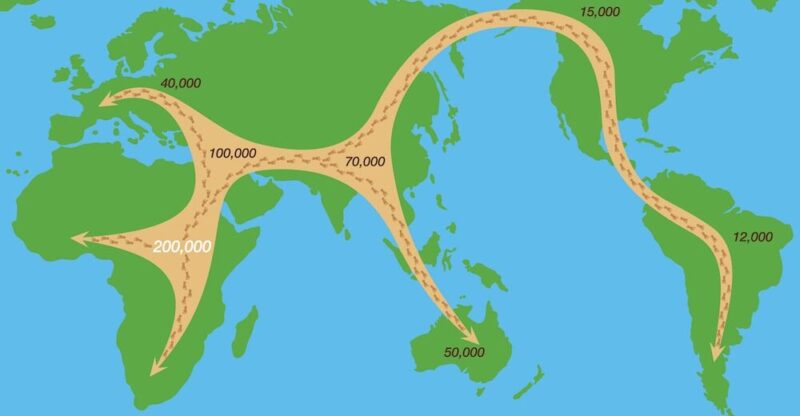We explain what primitive man is, his characteristics and his evolution. Plus, early hominins, discoveries, and more.
What is primitive man?
The term primitive man refers to the first humans who populated the Earth some 2,500,000 years ago with the beginning of prehistory . According to archaeological evidence, they arose from the evolution of primates.
The chimpanzee and the bonobo are hominid primate species that make up the genus called Pan. The species separated very slowly and gradually during the evolutionary process, giving rise to the subspecies or genus Homo , such as Homo habilis , Homo erectus or the Homo sapiens (group to which the human species belongs).
At present, by comparing genomes in a laboratory, it was confirmed that both genera (Pan and Homo ) have a common ancestor, dating back about 6 million years. According to archaeological evidence, it is estimated that the separation of species between primates took place in southern Africa.
There were various types of hominids and, today, Homo sapiens is one of those that managed to adapt to changes in the environment and survive. The extinction of species is usually part of the evolutionary process, as long as it does not occur abruptly and with a large number of species at the same time.
In the extensive evolutionary chain of hominid primates there were various species of homos, such as Homo habilis and even some of which fossil remains have not yet been discovered.
Characteristics of primitive man

Although the characteristics of primitive man vary according to each species, they all shared the following:
- Walking bipedally , that is, on two of its lower extremities.
- The development of the skeleton , with longer limbs and a shorter and more robust pelvis.
- The upright posture , although at first, with the back somewhat bent.
- The greatest increase in brain mass in proportion to body mass, one of the evolutionary processes called corticalization.
- Mental development , both conscious and unconscious, the result of brain activity, which is one of the evolutionary processes called cerebration.
- The development of the hands together with the brain capacity to control the fine motor skills of the movements.
- The development of more space in the cranial cavity and smaller jaws.
Evolution of primitive man

The evolution of primitive man involved small variations in the genetic material , that is, in the DNA (deoxyribonucleic acid) that contains the instructions for the development and functioning of the organism. The accumulation of genetic information during the passage of the different generations caused the evolutionary changes.
According to the theory most accepted by scientists, it is estimated that about 90,000 years ago Homo sapiens began to migrate from the African continent to various territories in Europe and Asia . Then, some 60,000 years ago, it spread across the Australian continent.
More than 13,000 years ago, during the last glacial period of the Ice Age , a land bridge was created that linked the continental masses of Asia and North America. It is estimated that primitive man could migrate to the American continent through this path.
In each case, the migratory movements had various reasons that forced individuals to mobilize to survive , such as lack of food and the need to search for new sources, harsh climatic conditions or natural disasters.
Important discoveries of primitive man

Primitive man, that is, the ancestors of the genus Homo and their predecessors, made key breakthroughs that changed the course of their offspring.
Among the main discoveries of prehistory, the following stand out:
- The carving of utensils. Primitive man made small tools and utensils carved in bone and stone that allowed him to shred the animals he hunted and to collect vegetables and fruits.
- The stone work. Primitive man made stonework with increasingly sophisticated techniques, such as polished stone that allowed him to make stronger tools, even to work the land.
- Control of fire . It was one of the most important discoveries for the development of primitive man. At first, it allowed him to warm up in the caves during the freezing nights and to scare away the wild animals.
- The sedentary lifestyle . After the end of the ice age, primitive man managed to adapt to a new lifestyle, ceasing to be nomadic to be able to settle in the same territory for a long period of time.
- Livestock agricultural practices. The sedentary lifestyle was perfected, in part, due to the discovery of planting food and raising animals, activities that allowed him to stock up on various foods almost constantly, something that did not usually happen with hunting and gathering.
- The creation of villages. From the sedentary life, during the Neolithic , the first large settlements emerged, along with the new food production systems. The first city-states and armies were created, defending the idea of private property and the acquisition of larger territories for their towns.
- The creation of writing and the end of an era. Around 3,500 a. C. the human being developed writing and was no longer considered primitive to be able to tell and transmit history through writing. Thus is the end of prehistory and the beginning of the history of mankind.
First hominids
According to the archaeological evidence that allowed the reconstruction of prehistory, among the first hominids are:
- Australopithecus . It is a species that shares more similarities with apes than with Homos. It evolved in East Africa about four million years ago and became extinct about two million years ago.
- Homo habilis . It is a species that existed at the same time as Australopithecus , although it had more similarities with humans and, especially, achieved a greater development of cranial capacity and ability with their hands.
- Homo erectus . It is a species after Homo habilis, dating back one and a half million years. It differed from previous hominids by its slimmer body build and taller stature. In addition, it had more cranial capacity.
- Homo sapiens neanderthalis . It is a subspecies of Homo erectus and the oldest evidence dates back 100,000 years. The name Neanderthal comes from the region in which the archaeological remains were found, in the Neander Valley in Germany. It was characterized by a smaller chin and even greater cranial capacity. It is the species that survived the glacial period and adapted to new living conditions.
- Homo sapiens sapiens . It is the species to which the current human being belongs. The oldest archaeological remains date back 50,000 years, in the Near East region and the Balkans, reaching their expansion towards America through the Bering Strait and, some 25,000 years ago, towards Australia.
Passionate about understanding and contributing to a world that does not stop changing. New forms of Work, Sustainability and Technology. For many years he has worked as a creative for large international companies. He has a Ph.D. in information technology and he has been doing quantitative research in the interdisciplinary areas of information systems, cyber security, data analytics and artificial intelligence. He continue to look for creative solutions through technology to help companies to be more humane and sustainable..
Leave a reply
Your email address will not be published. Required fields are marked *Recent post

Sport: What Is It, Types, Risks, Features, Characteristics and Examples

Dogs: Emergence, Features, Characteristics, Feeding and Breeds

Story: Definition, Elements, Structure, Features and Characteristics

